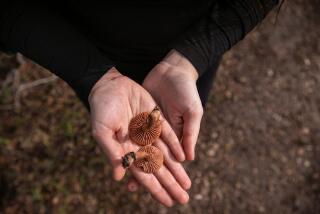Attack of the Giant Mushroom
- Share via
Giant mushrooms are taking over the produce section. Portobellos, really nothing more than brown crimini mushrooms that have matured another two or three days, have gone from almost nothing to a 10-million-pounds-a-year business in just three years.
“These have to be one of the hot food items in the country, not just in mushrooms,” says Wade Whitfield, president of the Mushroom Council, a grower industry group.
“When I started with this group two years ago, there was very little talk about portobellos. I have been told by producers that until three years ago, they couldn’t give these mushrooms away. They were culls; they were an accident that got tossed out.”
But they were getting attention from the restaurant trade, which liked their firm, meaty texture and deep, rich taste. And, eventually, they broke out into wide distribution.
“We’ve been doing them for about eight years,” says Kevin Donovan, sales manager at Phillips Mushroom Farms in Kennett Square, Pa. “I had seen some imported from Italy, but there weren’t many. The first year, there were maybe 150,000 pounds sold in the entire U.S.” This year, Phillips alone will account for almost 4 million pounds.
Portobellos are about as close to a wild mushroom as anything you’re likely to find in the grocery store. They’re great for grilling (just brush with a little garlic-parsley oil) or for sauteing or even roasting.
Although the name sounds Italian, it’s not. In Italy, both the crimini and the portobello ( Agaricus bisporus , for you Latin lovers) are called prataiolo , as is the plain white button mushroom ( A. albidus ). In fact, even within the industry, there is no agreement even on whether it is spelled portobello or portabella.
“As I understand it, the original name is portobello,” says Whitfield. “But when I started here, I did a poll of our membership, and five out of six producers spelled it portabella. I think that’s a little easier to say too.”
Like about 40% of the mushrooms sold commercially in this country, portobellos come predominantly from the area around Kennett Square, which is to the American mushroom trade what Gilroy is to garlic and Castroville is to artichokes.
The industry, Donovan says, started in the area in the late 1800s because it was close enough to several large cities for overnight delivery and “out here we had a lot of horse manure for compost.”



